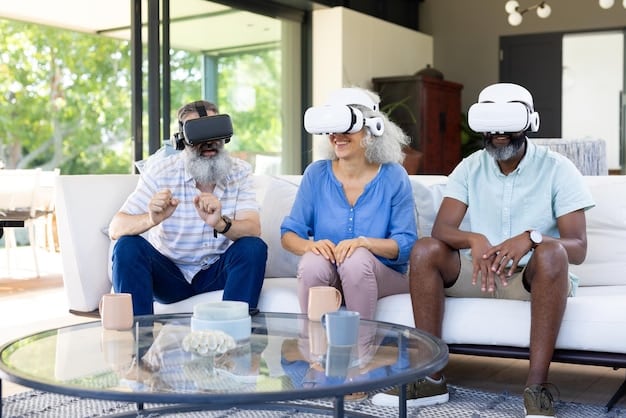VR Gaming on PC: Mainstream Ready for US in 2025?

Looking ahead to 2025, PC VR gaming is poised for significant growth within the US mainstream audience, driven by technological advancements, content diversification, and increasing accessibility. While challenges remain, the industry trajectory suggests a strong shift towards broader acceptance and adoption over the next year.
The immersive world of virtual reality has captivated imaginations for decades, promising unparalleled experiences. But for PC gamers, the question has always been: when will it truly arrive for the broader audience? We delve into whether VR Gaming on PC: Is It Finally Ready for the Mainstream US Audience in 2025? exploring the technologies, content, and market dynamics that will define its trajectory.
The Evolving Landscape of PC VR Technology
Virtual reality technology has undergone a remarkable transformation in recent years, moving from niche, often cumbersome prototypes to more refined and accessible consumer products. For PC VR, this evolution has been particularly critical, addressing many of the initial barriers to mainstream adoption. From improved display resolutions to more precise tracking systems, the underlying hardware is becoming increasingly capable.
In 2025, we anticipate further refinements in key areas that directly impact user experience. Enhanced display technologies like micro-OLED and improved lens designs are set to reduce the “screen-door effect” and expand the field of view, making virtual worlds even more convincing. The demand for higher fidelity visuals is constant, and hardware manufacturers are responding with resolutions that push the boundaries of what consumers can expect from their standalone and PC-tethered headsets.
Headset Innovation and Accessibility
The market for VR headsets is diversifying, offering a wider array of choices to consumers. While high-end options like Varjo Aero or Pimax provide unparalleled visual fidelity, more consumer-friendly and competitively priced headsets are crucial for mainstream penetration. Companies like Meta, HTC, and Valve continue to iterate on their designs, focusing on comfort, ease of use, and a smoother setup process. This push for user-friendliness is paramount for attracting a wider audience beyond just early adopters.
- Lighter and More Comfortable Designs: Reducing headset weight and improving strap ergonomics for longer play sessions.
- Wireless PC VR Solutions: Advancements in Wi-Fi 6E and future wireless protocols allowing for untethered PC VR experiences with minimal latency.
- Inside-Out Tracking Improvements: More robust and accurate tracking without external base stations, simplifying setup for new users.
- Integrated Audio Solutions: Better built-in headphones or speaker systems for more immersive soundscapes.
Ultimately, the technological improvements are not just about raw power, but about making the experience seamless and enjoyable. As headsets become more comfortable, easier to set up, and provide a clearer visual window into virtual worlds, the friction points for new users diminish significantly. This focus on accessibility, combined with growing performance, positions PC VR for a more prominent role in the gaming scene by 2025.
Content is King: The Expanding PC VR Game Library
While hardware advancements lay the groundwork, it’s the quality and diversity of content that truly drives mainstream adoption. For a long time, PC VR gaming suffered from a chicken-and-egg problem: limited content meant limited adoption, and limited adoption meant less incentive for developers to create AAA titles. However, this dynamic is visibly shifting, with a growing number of compelling games entering the ecosystem.
In 2025, we expect to see the fruits of several years of development, with a more mature and varied game library. Major studios are increasingly investing in VR, recognizing its potential for unique gameplay mechanics and deeply immersive storytelling. This includes not only VR-exclusive titles but also VR modes or experiences integrated into highly anticipated flatscreen games, broadening their appeal.
Genres and Developer Investment
The range of genres available in PC VR is expanding beyond typical action and horror titles. While these remain popular due to their inherent suitability for immersion, we’re seeing more strategy, simulation, puzzle, and even social VR experiences. This diversification appeals to a wider demographic, ensuring there’s something for every type of gamer. The success of titles like Half-Life: Alyx demonstrated the power of a flagship VR experience, and similar high-budget projects are now in various stages of development.
- Enhanced VR Ports: More existing flatscreen games receiving high-quality, dedicated VR ports or play modes.
- Live Service VR Games: Development of long-term, evolving VR titles with continuous content updates, fostering community.
- Cross-Platform Playability: Increased interoperability between different VR platforms, expanding player bases for online titles.
- Independent Developer Innovation: Continued experimentation and unique concepts from indie studios, often pushing design boundaries.
Moreover, developer tools and engines are becoming more VR-friendly, streamlining the creative process. This lower barrier to entry for development means more content, faster. The continuous flow of new, high-quality VR experiences, coupled with the deepening of existing titles, is crucial for convincing the average PC gamer that a VR setup is a worthwhile investment. The sheer breadth of engaging content will be a primary driver for mainstream interest by 2025.
Performance Demands and PC Hardware Readiness

One of the most significant barriers to entry for PC VR has traditionally been the demanding hardware requirements. To deliver truly immersive and smooth experiences without motion sickness, VR necessitates very high frame rates and resolutions, placing a heavy load on graphics cards and processors. For a long time, only the most expensive, top-tier gaming PCs could reliably run VR titles at their best, limiting the addressable market.
However, as we approach 2025, the landscape of PC hardware has shifted considerably. Mid-range and even upper-entry-level graphics cards are now significantly more powerful than their predecessors, capable of delivering commendable VR performance. Processor technology has also evolved, offering more cores and threads, which benefit complex VR physics and large game worlds.
Optimizing for VR and Hardware Trends
Game developers are also becoming more adept at optimizing their VR titles for a wider range of hardware specifications. Techniques such as foveated rendering (where only the area the user is looking at is rendered in full detail) and dynamic resolution scaling are becoming more commonplace, allowing for better performance on less powerful systems without sacrificing much visual quality. This optimization is key to broadening the access point for consumers.
- GPU Price/Performance Improvements: Continuing trend of better graphics performance at more accessible price points.
- CPU Multithreading Benefits: Modern CPUs better handling the parallel processing demands of VR applications.
- VR-Specific Software Optimizations: GPU drivers and VR runtimes continuing to improve, enhancing performance across hardware.
- Ready-Made VR PC Bundles: Increasing availability of pre-built PCs marketed specifically as “VR-ready”, simplifying purchasing decisions.
The combination of more powerful, yet increasingly affordable, PC components and better software optimization means that the “VR-ready” bar is becoming lower. A mainstream PC gamer in 2025 is more likely to already own a system capable of running a good VR experience than they were just a few years prior. This natural upgrade cycle for PC hardware users is a silent but powerful driver for VR adoption, turning an expensive niche into an attainable enhancement for many.
Addressing the User Experience: Setup, Comfort, and Motion Sickness
Beyond raw technical specs and content, the overall user experience is paramount for mainstream acceptance. Early VR experiences were often plagued by cumbersome setups, discomfort, and the notorious issue of motion sickness. For PC VR to truly hit the mainstream in 2025, these common concerns must be effectively mitigated, if not entirely eliminated.
Headset manufacturers and software developers are acutely aware of these pain points and are actively working on solutions. Simplification of the setup process, better ergonomic designs, and clever software techniques are all contributing to a more comfortable and enjoyable VR journey, even for newcomers.
Overcoming Barriers to Entry
The days of needing multiple external sensors and elaborate cable management for PC VR are largely behind us. Inside-out tracking, popularized by standalone headsets and now robustly integrated into PC VR solutions, dramatically simplifies setup. Users can often be in a virtual environment within minutes of unboxing their headset, a far cry from earlier generations.
- Simplified Calibration: Automated room setup and boundary definition, reducing manual intervention.
- Improved Ergonomics and Weight Distribution: Headsets designed for extended wear, lessening strain on the neck and face.
- Software Comfort Settings: Built-in options like vignetting, teleport locomotion, and reduced artificial turning to combat motion sickness.
- Enhanced Hygiene Materials: More easily cleanable and breathable face pads, especially important for shared experiences.
Motion sickness, while not entirely curable for everyone, is being effectively minimized through a combination of hardware and software design. Higher refresh rates reduce visual latency, smoother locomotion options provide more comfortable movement, and developers are designing games with comfort in mind. As these aspects of the user experience become more refined and less intimidating, the average consumer will feel more confident diving into PC VR, recognizing that a barrier that once seemed insurmountable is now largely a thing of the past.
The Role of Standalone VR and Cross-Compatibility
The rise of standalone VR headsets, particularly Meta’s Quest line, has undeniably played a crucial role in bringing VR to a much broader audience. These devices offer an accessible, untethered VR experience right out of the box, often at a lower price point than a full PC VR setup. While seemingly distinct, the success of standalone VR has a symbiotic relationship with PC VR, benefiting the entire ecosystem.
In 2025, we anticipate this relationship to strengthen, pushing PC VR closer to the mainstream. Standalone headsets are often the first VR experience for many users. Once they’ve tasted the immersion, many become interested in the higher fidelity and broader content library that PC VR offers, acting as a gateway or upgrade path.
Bridging the Gap
Technologies like Meta’s Air Link and Virtual Desktop (third-party) allow Quest users to seamlessly connect to their gaming PCs wirelessly, turning a standalone device into a powerful PC VR headset. This flexibility means that consumers aren’t forced to choose between a standalone untethered experience and a high-fidelity PC VR experience; they can have both with a single piece of hardware.
- Unified Development Ecosystems: Developers increasingly target both standalone and PC VR simultaneously, expanding game availability.
- VR as a “Gateway Drug”: Standalone devices introducing new users to VR, many of whom then seek higher-end PC VR experiences.
- Innovation on Standalone Driving PC VR: Advancements in standalone tracking and display technology often migrating to PC VR headsets.
- Broader Consumer Awareness: Marketing for standalone VR raising general public awareness and interest in all forms of VR.
The market is no longer a strict binary between standalone and PC VR but rather a continuum. This cross-compatibility and shared technological advancements mean that the increasing user base of standalone VR directly feeds into the potential mainstream adoption of PC VR. By 2025, it will be common for consumers to start with a standalone headset and eventually explore its PC VR capabilities, solidifying VR as a recognized and desired gaming platform.

The Road Ahead: Challenges and Opportunities for 2025
While the momentum for PC VR moving into the mainstream for the US audience by 2025 is strong, it’s crucial to acknowledge the remaining hurdles and the opportunities that can accelerate this growth. No technology reaches full mainstream adoption without overcoming significant challenges, and VR is no exception. These challenges range from economic factors to continued technological refinement.
However, each challenge also presents an opportunity for innovation and market expansion. The companies and developers who effectively address these remaining points will be the ones that truly unlock VR’s potential for the masses, especially in the competitive US gaming market.
Key Obstacles and Future Prospects
One of the primary challenges remains the cost of entry, despite decreasing hardware prices. A high-end PC combined with a premium VR headset still represents a substantial investment for the average consumer. Additionally, awareness and understanding of VR among the general public, while growing, still need to improve. Many potential users may still view it as a gimmick or too complex to set up.
- Price vs. Performance Equilibrium: Finding the sweet spot where high-quality VR is affordable without compromising experience.
- Marketing and Education: Better communication to the public about VR’s benefits, ease of use, and diverse content.
- Standardization Across Platforms: Reducing fragmentation in software and hardware for a more seamless user experience.
- Longevity of Content Post-Launch: Ensuring ongoing developer support and new content for existing popular titles.
Looking to 2025, the opportunities lie in continuous content refinement, more accessible pricing models, and improved marketing that emphasizes the unique benefits of VR. The gradual expansion of the VR arcade scene and VR esports could also play a role in increasing public exposure and interest. Ultimately, the question of whether PC VR is ready for the mainstream US audience in 2025 hinges on the industry’s ability to consistently deliver high-value experiences that justify the investment, reduce friction, and resonate with the diverse preferences of mainstream gamers. The trajectory indicates a resounding “yes,” but full integration into the common household gaming setup is an ongoing journey.
| Key Point | Brief Description |
|---|---|
| 🚀 Tech Advancements | Lighter headsets, better displays, and wireless solutions enhance user experience and accessibility. |
| 🎮 Content Explosion | Diverse game genres and increased AAA developer investment are enriching the VR game library. |
| 💪 Hardware Readiness | More affordable and powerful PCs coupled with better VR optimization make high-fidelity VR accessible. |
| 🔗 Standalone Synergy | Standalone VR acts as a gateway, fostering wider interest and seamless transition to PC VR. |
Frequently Asked Questions about PC VR Gaming in 2025
▼
PC VR leverages the powerful graphics processing unit (GPU) and central processing unit (CPU) of a desktop computer. This allows for significantly higher resolutions, more complex game worlds, richer graphical detail, and more advanced physics simulations compared to the self-contained hardware of standalone headsets. Users often experience superior visual fidelity and a wider variety of graphically intensive titles.
▼
While some individuals are more prone to motion sickness, technological advancements are continually mitigating the issue. Higher refresh rates in headsets, foveated rendering techniques, and improved game design (offering comfort settings like teleportation locomotion) significantly reduce the likelihood. By 2025, the overall VR experience will be much smoother and more comfortable for a larger portion of the population.
▼
By 2025, mid-range to high-end graphics cards from the previous two generations (e.g., NVIDIA RTX 30-series or AMD RX 6000-series and newer) combined with modern multi-core processors should offer excellent VR experiences. The bar for “VR-ready” continues to lower, meaning many standard gaming PCs will be capable, especially with ongoing software optimizations and improved headset efficiency.
▼
Besides traditional action and horror, 2025 will likely see an expansion into more complex simulation games, persistent online multiplayer worlds, and narrative-driven titles that fully utilize VR’s unique immersion. Expect more non-gaming applications like virtual workspaces and social platforms to also blend with gaming, offering richer interconnected experiences. Developers are also refining VR versions of popular flatscreen genres.
▼
Standalone VR acts as a crucial entry point for many new users, exposing them to virtual reality without the need for a PC. Once hooked, these users often seek out the higher fidelity and broader content library offered by PC VR, viewing it as a natural upgrade. The cross-compatibility between standalone headsets and PCs further blurs the lines, making VR more versatile and appealing to a wider audience.
Conclusion
As we look forward to 2025, the trajectory for VR Gaming on PC: Is It Finally Ready for the Mainstream US Audience? appears decidedly positive. The convergence of increasingly accessible and powerful hardware, a burgeoning library of high-quality content, and significant advancements in user comfort and experience are collectively dismantling the traditional barriers to entry. What was once a niche pursuit for early adopters is now rapidly evolving into a more refined, palatable, and genuinely compelling entertainment medium. While challenges such as cost and broader public education persist, the industry’s dedicated efforts in these areas, coupled with the synergistic growth of standalone VR, indicate that PC VR is not just ready, but poised for a significant push into the everyday gaming habits of the US mainstream audience. The immersive future is here, and it’s clearer, smoother, and more inviting than ever before.





